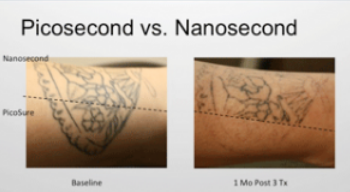
Tattoos are getting increasingly popular in the past decade. While a tattoo brings to mind secret societies, bikers or branded outcasts previously, it’s a common sighting on the young and trendy now. A survey estimated that about 36% of Americans aged between 18 to 30 years have at least one tattoo. Up to 65% of ink bearers are women.

So what exactly is the allure of the tattoo? Perhaps, it is the promise that an ordinary unadorned stretch of skin will be transformed into a canvas for a permanent, powerful and unique statement – either artistic or counter-cultural – of cool for some. For other ladies, they may have tattoos masked as “permanent makeup” such as eyebrow hair imitation, or permanent lip liner and eye liner. Whatever the motivation for getting inked permanently, here’s what you need to know about tattoos, safety tips, the possible health risks involved, and your removal options if you change your mind.
What It Involves
A tattoo is a permanent mark or design made on the body when insoluble pigment is inserted into the dermal (deeper) layer of the skin. Modern-day professional tattoos are generally applied by using an electric tattoo machine or “tattoo gun” with needles that rapidly puncture the skin (between 50 and 3,000 times per minute) with an up and down motion like a sewing machine. Tiny ink droplets are injected into the skin with each puncture.
The process has been described to feel similar to bee stings or sunburns. Placement, size, type and artist skill, however, can all make a difference.
If You are Going to Get Tattoo
1. Take your time to find the right tattoo studio and a reputable artist. Some get lucky with the nearest random studio and walk away with a great tattoo, while others don’t. So do your research, talk to friends with tattoos for recommendations, look at the artist’s portfolio and speak to the artist to see if his style fits you. A final word of advice – a good tattoo isn’t cheap and a cheap tattoo isn’t good.
2. Choose the location of your tattoo as carefully as the design. The ribs will hurt, but guess what, the butt will hurt the most! Tattoos on the torso are the most tedious and requires the most number of breaks.
3. If you are getting words in your tattoo, have them proof-read.
4. A healing tattoo is mildly uncomfortable and feels almost like a sunburn. Activities in the water or out in the sun are not allowed.
5. Any tattoo regret can be dealt with by a laser tattoo, such as the laser tattoo removal program by SW1 Clinic, which uses a picosecond laser. But be warned, everyone who has had a tattoo removed says it hurts more than getting the tattoo itself. Multi-coloured tattoos are the most difficult to remove. Black tattoos are the easiest.
How Laser Tattoo Removal Works
Tattoo ink pigments are broken up into small fragments, like a mini explosion under the skin, when the laser beam is fired into the tattoo. These fragments are then removed gradually by one’s own body. The laser creates heat injury under the skin, so patients will need to be numbed with topical numbing cream before the procedure. The skin over the tattoo then appears red and slightly swollen after the procedure, it generally takes 2 to 3 weeks for the skin to heal. Multi-coloured tattoos, especially tattoos that have yellow and red pigments are the hardest to remove.

Previously nanosecond Q-switched lasers such as the Medlite or Revlite were the workhorses of tattoo removal laser treatments. Now, the latest second generation Picosecond lasers are used to remove tattoos. It has three wavelengths, two of which are identical with the traditional nanosecond Q-switched Nd:Yag laser, and an additional wavelength, a Ruby laser, which effectively allows for treatment of more multi-coloured tattoos, which the traditional laser doesn’t have. Picosecond lasers are a lot faster than traditional lasers and accordingly, more efficient overall (less sessions required to remove a tattoo) and less painful. Picosecond lasers are able to photoacoustically fragment tattoo ink particles into very, very small sizes – a fine dust, which makes it much easier for the body to clear.
Read more: Think Before You Ink – Tattoo Regret In The Eyes Of A Doctor
Getting a tattoo is a very personal choice, it may not be a bad thing – tattoo lovers say their tattoos remind them of the memorable events or people of their lives, even if they are no longer a part of it. But in case anyone is unable to live with their tattoo, know that there is at least a reasonably effective way to get rid of it!
Read More: Are You Committing These Nighttime Beauty Blunders?
